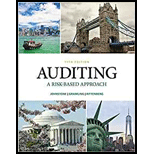
Introduction: Internal control risks are risks which affects the effectiveness and controllability of the internal controls. The book value risks are those risks which affect the status of the conclusion of the account.
Requirement 1
Define the incorrect acceptance and rejection risk of internal control reliability and book value.
Introduction: Internal control risks are risks which affects the effectiveness and controllability of the internal controls. The book value risks are those risks which affect the status of the conclusion of the account.
Requirement 2
Most concerning risk for the auditor among four.
Trending nowThis is a popular solution!

Chapter 8 Solutions
Bundle: Auditing: A Risk Based-approach, 11th + Mindtap Accounting, 1 Term (6 Months) Printed Access Card
- provide correct answerarrow_forwardInternal control refers to the processes and procedures implemented by an organization to ensure the integrity of financial and accounting information, promote accountability, and prevent fraud. These controls are designed to provide reasonable assurance that the organization achieves its objectives in operational efficiency, financial reporting reliability, and compliance with laws and regulations. Internal control is a comprehensive system that includes a variety of checks and balances, such as segregation of duties, authorization and approval processes, reconciliations, and physical security measures. It is an integral part of an organization's governance framework, helping to safeguard assets, improve operational efficiency, and ensure accurate and timely financial reporting. Respond to the above postarrow_forwardI need the correct answer to this general accounting problem using the standard accounting approach.arrow_forward
- You are a team of accounting consultants hired by the company VinGrenDom Ltd., a regional utility and manufacturing firm expanding into the Eastern Caribbean. The Board of Directors is requesting an accounting report that addresses three critical areas in their financial statements. Part A: Working Capital 1. Define working capital and explain its importance in financial health and liquidity management. 2. Assess how the matching concept and accrual basis affect the reporting of current assets and liabilities. 3. Using a hypothetical balance sheet (you may create one), identify at least 5 current assets and 5 current liabilities and analyze how changes in these elements affect liquidity ratios. 4. Recommend at least two strategies VinGrenDom Ltd. can implement to optimize working capital.arrow_forwardProvide best solution accountingarrow_forwardGeneral Accounting solve this problemarrow_forward
- Explain the theoretical concepts underlying equity (e.g., residual interest, stewardship, and proprietary theories)arrow_forwardGeneral Accounting Questionarrow_forwardSea Harbor, Inc. has a marginal tax rate of 35 percent and an average tax rate of 22 percent. If the firm earns $79,500 in taxable income, how much will it owe in taxes? a. $10,335. b. $16,695. c. $17,490. d. $27,030. e. $27,825.arrow_forward
 Auditing: A Risk Based-Approach (MindTap Course L...AccountingISBN:9781337619455Author:Karla M Johnstone, Audrey A. Gramling, Larry E. RittenbergPublisher:Cengage Learning
Auditing: A Risk Based-Approach (MindTap Course L...AccountingISBN:9781337619455Author:Karla M Johnstone, Audrey A. Gramling, Larry E. RittenbergPublisher:Cengage Learning Auditing: A Risk Based-Approach to Conducting a Q...AccountingISBN:9781305080577Author:Karla M Johnstone, Audrey A. Gramling, Larry E. RittenbergPublisher:South-Western College PubBusiness/Professional Ethics Directors/Executives...AccountingISBN:9781337485913Author:BROOKSPublisher:Cengage
Auditing: A Risk Based-Approach to Conducting a Q...AccountingISBN:9781305080577Author:Karla M Johnstone, Audrey A. Gramling, Larry E. RittenbergPublisher:South-Western College PubBusiness/Professional Ethics Directors/Executives...AccountingISBN:9781337485913Author:BROOKSPublisher:Cengage EBK CONTEMPORARY FINANCIAL MANAGEMENTFinanceISBN:9781337514835Author:MOYERPublisher:CENGAGE LEARNING - CONSIGNMENT
EBK CONTEMPORARY FINANCIAL MANAGEMENTFinanceISBN:9781337514835Author:MOYERPublisher:CENGAGE LEARNING - CONSIGNMENT




